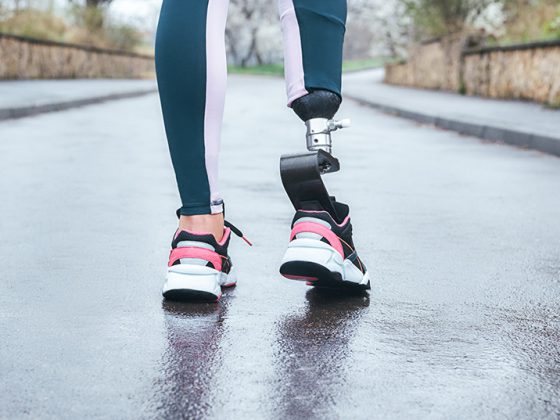Osteoporosis is severely underdiagnosed despite serious consequences, and many patients at increased risk of fracture remain untreated [1, 2]. The Swiss Association Against Osteoporosis (SVGO) now provides clear therapy recommendations depending on the fracture risk [3].
Osteoporosis is the most common skeletal disease and leads to fracture in one in three women over 50 years of age, often resulting in serious health, social, and economic consequences [4]. For example, hip fractures are associated with a mortality rate of up to 20 percent within one year [5]. In addition, after the first fracture, the risk of suffering a second one doubles [6]. Therefore, a key goal of osteoporosis management is to prevent the occurrence of fractures through timely and effective intervention [7]. However, because typical symptoms are often absent at the onset of the disease, diagnosis often does not occur until the first fracture [1, 8]. In Switzerland, for example, according to a European observational study, about two-thirds of women over 70 years of age with an increased risk of fracture do not receive osteoporosis treatment [2]. Thus, considering the serious consequences, it is important to respond to the first signs of osteoporosis and initiate appropriate treatment at an early stage [9, 10].
SVGO recommendations support timely therapy selection
Drug treatment is indicated in patients at increased risk of fracture. The SVGO recommendations, updated in September 2020, now provide guidance on which drugs should be used and for which fracture risk [3]. Risk classification is based on previous fractures, bone mineral density (BMD), and clinical risk factors(fracture risk assessment tool, FRAX), among others, and newly distinguishes between high and very high or imminent risk within the increased risk (Figure 1) [3]. The SVGO recommends anabolic treatment followed by antiresorptive therapy for patients at very high risk; patients at high risk of fracture should initially receive antiresorptive therapy (see infobox) [3, 10]. This can be started with denosumab (Prolia®) or bisphosphonates. While bisphosphonates only inhibit osteoclast function, denosumab also prevents their formation, activation, and survival [11, 12]. In this context, denosumab leads to an early and continuous increase in BMD with improved bone strength, both in cortical and trabecular bone [13]. Bisphosphonates, on the other hand, act predominantly on trabecular bone and reach a plateau in bone density increase [13, 14].

Figure 1: Classification of fracture risk according to SVGO Recommendations 2020 (adapted from [3]).
| Therapy selection based on fracture risk according to SVGO recommendations 2020 [3].
High risk Patients at high risk of fracture should receive denosumab or a bisphosphonate. If the fracture risk is still high after four to five years on denosumab or after three or five years on an intravenous or oral bisphosphonate, long-term therapy with denosumab is recommended [7]. In the case of vertebral fracture, 18- to 24-month treatment with teriparatide may be considered, followed by denosumab or bisphosphonates [3]. Very high / Imminent risk Patients at imminent or very high risk, regardless of the location of the osteoporotic fracture, are recommended one year of treatment with romosozumab followed by long-term denosumab or bisphosphonate follow-up therapy. If a hip or vertebral fracture is present, the patient can also be treated with zoledronate or, alternatively, denosumab or teriparatide followed by denosumab or bisphosphonates [3].
|
Fracture risk reduced in the long term with denosumab
In order to permanently prevent osteoporotic fractures, according to the new recommendations, denosumab should be used both as first-line therapy for high fracture risk and as follow-up therapy to time-limited anabolic treatment for very high and imminent fracture risk [3]. Results from the randomized phase III FREEDOM trial show that compared with placebo, biannual administration of denosumab can significantly reduce the risk of new vertebral fractures, nonvertebral fractures, and hip fractures as well as increase BMD with good tolerability after only three years [15]. That the efficacy of denosumab actually increases in the long term is shown by the data from the open-label extension of the FREEDOM trial, in which all patients who had not missed more than one dose of denosumab or placebo over three years were eligible to participate [16].
Compared with the first three years of treatment, the risk of nonvertebral fractures was further reduced after up to ten years under denosumab, which was not observed in comparable follow-up studies with bisphosphonates [16, 17].
In addition to increasing efficacy, denosumab long-term therapy also showed a good safety profile [16]. If a change in therapy is considered, the reversibility of beneficial effects under denosumab must be taken into account and temporary bisphosphonate treatment must be initiated after discontinuation to counteract loss of bone density [7].
| Continuous therapy also essential in the COVID 19 pandemic
To keep the fracture risk permanently low, denosumab should therefore be used on a long-term basis. Given the potentially devastating consequences of osteoporosis diagnosed too late and thus not adequately treated, continued treatment is essential even during the COVID-19 pandemic. If continuation of therapy is not possible in the office due to the current situation, denosumab may also be administered after appropriate patient instruction. |
Conclusion
Most women at increased risk for osteoporotic fractures do not receive adequate treatment in Europe, including Switzerland [2]. In this context, timely therapies tailored to the individual fracture risk can significantly reduce the occurrence of fractures and their often serious consequences [4, 10, 15, 18-20]. The new SVGO recommendations can assist physicians in identifying high or very high or imminent fracture risk to make adequate treatment choices based on this information [3]. According to the FREEDOM study, antiresorptive treatment with denosumab was able to significantly and permanently reduce the risk of fracture with a favorable safety profile [16]. According to the new SVGO recommendations, denosumab is intended as first-line therapy for high fracture risk and as long-term follow-up treatment after anabolic therapy for very high or imminent fracture risk [3].
The new SVGO recommendations 2020 briefly and understandably explained in the following video:
CH-PRO-0121-00003
With financial support from Amgen Switzerland AG.
Brief technical information Prolia®

Literature
Contribution online since 10.03.2021














